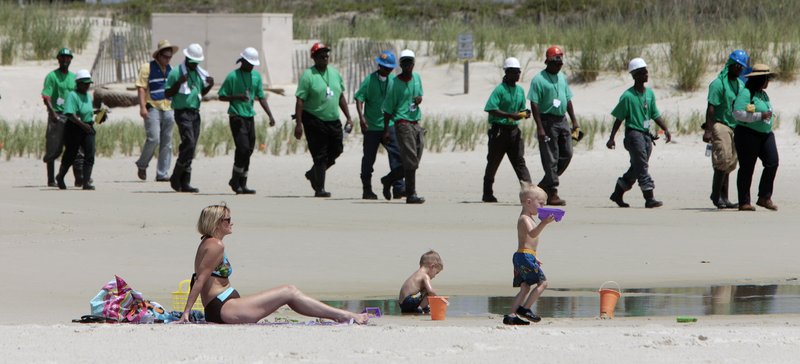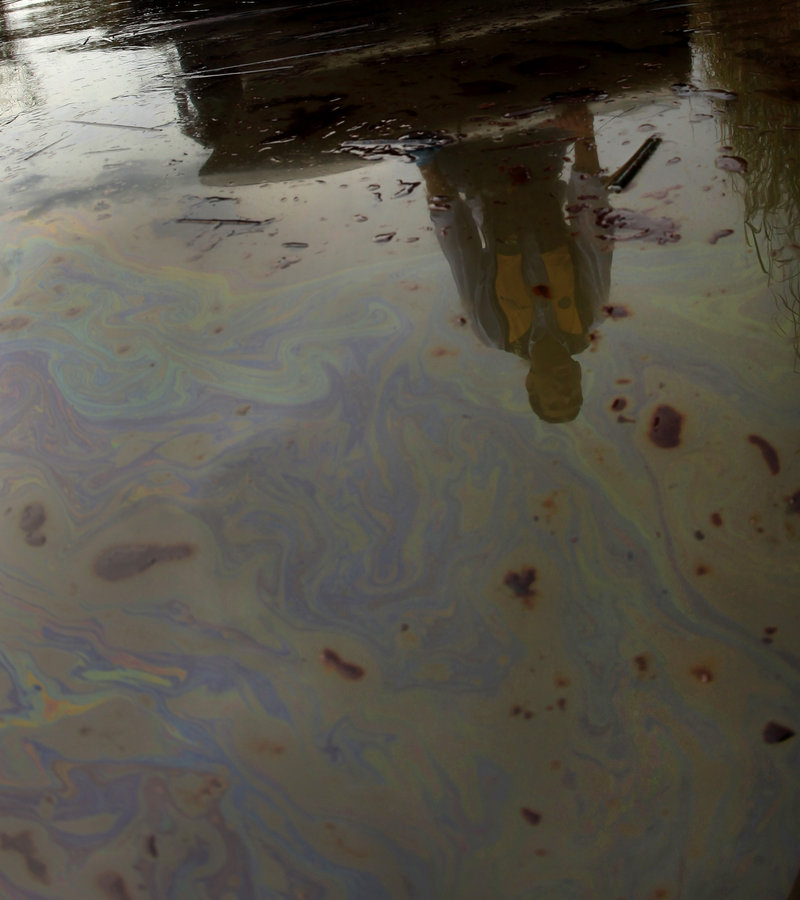PENSACOLA, Fla. — The BP oil slick drifted perilously close to the Florida Panhandle’s famous sugar-white beaches Wednesday as a risky gambit to contain the leak ran into trouble a mile under the sea.
A diamond-tipped saw being used to shear off the crumpled well pipe snagged as it cut halfway into the pipe, and it took BP 12 hours to free it. The company said it hoisted the saw back to the surface after finally yanking it out of the pipe.
BP engineers now will turn to giant shears to slice off the leaking pipe, said Lt. Commander Tony Russell, an aide to Coast Guard Adm. Thad Allen, the government’s point man in the crisis.
The plan is to fit a cap on the blown-out well at the bottom of the Gulf of Mexico to capture most of the spewing oil; the twisted, broken pipe must be sliced first to allow a snug fit.
The shears have already been used to slice off another part of the pipe, but crews had hoped to use the diamond saw to get a finer cut so they could deploy a dome that would fit the pipe more snugly.
“I don’t think the issue is whether or not we can make the second cut. It’s about how fine we can make it, how smooth we can make it,” Allen had said earlier.
As the edge of the slick drifted within seven miles of Pensacola’s beaches, emergency workers rushed to link the last in a miles-long chain of booms designed to fend off the oil. They were slowed by thunderstorms and wind before the weather cleared in the afternoon.
Forecasters said the oil would probably wash up by Friday, threatening a delicate network of islands, bays and sandy beaches that are a haven for wildlife and a major tourist destination dubbed the Redneck Riviera.
“We are doing what we can do, but we cannot change what has happened,” said John Dosh, emergency director for Escambia County, which includes Pensacola.
Allen said more staff, boats and helicopters were sent to the eastern Gulf Coast as the slick spread, including a cutter in Mobile Bay, Ala., and one off Pensacola. The boats will help skim oil and add more booms to collect it. Four helicopters would help skimmers spot threatening oil.
The latest attempt to control the leak is considered risky because slicing away a section of the 20-inch-wide riser could remove kinks in the pipe and temporarily increase the flow of oil by as much as 20 percent.
If the strategy fails – like every other attempt to control the leak 5,000 feet under water – the best hope is probably a relief well, which is at least two months from completion.
As the oil drifted closer to Florida on Wednesday, beachgoers in Pensacola waded into the gentle waves, cast fishing lines and sunbathed, even as a two-man crew took water samples. One of the men said they were hired by BP to collect samples to be analyzed for tar and other pollutants.
A few feet away, Martha Feinstein, 65, of Milton, Fla., pondered the fate of the beach she has been visiting for years. “You sit on the edge of your seat and you wonder where it’s going,” she said. “It’s the saddest thing.”
Officials said the slick sighted offshore consisted in part of “tar mats” about 500 feet by 2,000 feet in size.
County officials set up the booms to block oil from reaching inland waterways, but planned to leave beaches unprotected because they are too difficult to defend against the action of the waves and because they are easier to clean up.
“It’s inevitable that we will see it on the beaches,” said Keith Wilkins, deputy chief of neighborhood and community services for Escambia County.
Florida’s beaches play a crucial role in the state’s tourism industry. At least 60 percent of vacation spending in the state during 2008 was in beachfront cities. Worried that reports of oil would scare tourists away, state officials are promoting interactive Web maps and Twitter feeds to show travelers – particularly those from overseas – how large the state is and how distant their destinations may be from the spill.
In other developments Wednesday:
• Investors ran from BP’s stock for a second day, fearful of the potential cleanup costs, lawsuits, penalties and damage to the company’s reputation.
• President Obama said it is time to roll back billions of dollars in tax breaks for oil companies and use the money for clean energy research and development.
• More fishing grounds were closed. More than one-third of federal waters in the Gulf are now off-limits to fishing, along with hundreds of square miles of state waters.
“I’m going to be bankrupt very soon,” said fisherman Hong Le, who came to the U.S. from Vietnam and rebuilt his home and business after Hurricane Katrina in 2005 wiped him out.
“Everything is financed,” he said. “How can I pay? No fishing, no welding. I weld on commercial fishing boats and they aren’t going out now, so nothing breaks.”
Send questions/comments to the editors.




Success. Please wait for the page to reload. If the page does not reload within 5 seconds, please refresh the page.
Enter your email and password to access comments.
Hi, to comment on stories you must . This profile is in addition to your subscription and website login.
Already have a commenting profile? .
Invalid username/password.
Please check your email to confirm and complete your registration.
Only subscribers are eligible to post comments. Please subscribe or login first for digital access. Here’s why.
Use the form below to reset your password. When you've submitted your account email, we will send an email with a reset code.